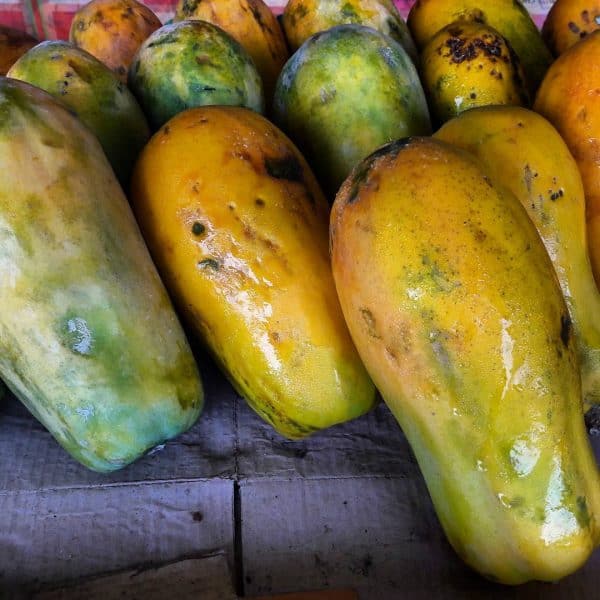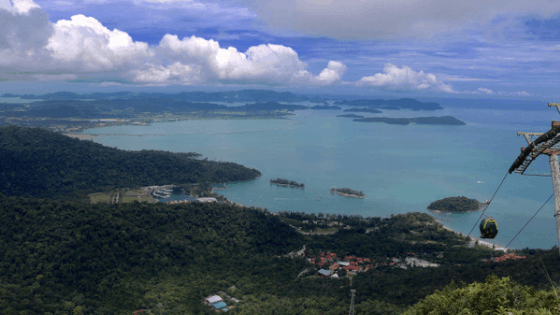Fruit is a big deal in Malaysia. Local Malaysian fruit is especially popular. It’s an abundant and generally affordable, local snack you simply shouldn’t pass up. But no one wants to carry around a bunch of weird-looking fruit that you may or may not actually eat, right? Trust me, attempting to buy a handful of fruit from smiling vendors can be a true test of one’s travel sensitivities. Those folks drive a hard bargain and can melt your heart with their enthusiasm and smiles. So, expect to walk away with at least a kilo!
But hey, if you’re going to haul around a kilo of fruit it should probably be a sure-fire winner. So here’s a rundown of my top picks of Malaysian fruit and a few fun facts to help make those tasty treats become fond memories and great travel experiences.
BANANA (Pisang)
Yes, you may think bananas are a no-brainer when it comes to Malaysian fruit, but there are regular bananas and then there are ‘cooking’ bananas (pisang tandung or plantains). Be sure to grab the right ‘bunch’. Also as a rule of thumb, buying from a local market, rather than a super market will usually get you a better price as well as better tasting bananas. Banana flowers (jatung pisang) are also edible and highly prized in Malaysia. Do note that bananas growing seemingly wild on the side of the road are not usually free for the taking. They belong to someone, so don’t take them without permission.
Bananas at markets can be easily cut into smaller bunches. Just ask the vendor.
Pisang Goreng (Fried Banana) is a local favorite.
COCONUT (Kelapa)
Coconuts are flat out fascinating. And yes, they are considered a Malaysian fruit and not a nut. The word coconut can actually refer to the entire coconut palm and every part of the coconut fruit and the tree is useful. You can read more about coconuts HERE.
Look for coconut vendors along the roadsides and at various markets throughout Malaysia.
DRAGON FRUIT or PITAYA (Buah Naga)
The exotic looking dragon fruit is cultivated in Southeast Asia. They are a member of the cactus family. The fruit’s interior is similar to kiwi fruit with many tiny chewable seeds. The inside fruit comes in a white or red color, making them quite decorative as well as tasty.
Dragon fruit belongs to the cactus family!
DURIAN
Durian is for sure an acquired taste, but I have never met a Malaysian who didn’t absolutely love their precious, ‘King of Fruit’. The name durian is derived from the Malay word for ‘spike’, which of course is in reference to the durians medieval looking spiked husk. The inner fruit is a yellow color with a creamy texture. Unfortunately, it has an unpopular aroma, which has it banned from most hotels and resorts. There are at least nine different edible varieties and the quality will definitely be a consideration in their prices. The Musang King is the Rolls Royce of durians with prices in the 60ringgit per kilo range and higher.
Durian are seasonal so don’t expect to always find them available.
And do remember, that the higher the quality the higher the price.
JACKFRUIT ( Nangka )
Jackfruit appear to defy gravity as their massive size grows directly from the tree and is secured by its own mini branch. Jackfruit has a unique flavor and are often used in various curry dishes as well as fried. Nangka looks very similar to Cempedak, except the Cempedak is more cylindrical in shape and has a smoother outer surface. Cempedak can also smell a bit pungent.
Nangka and Cempedak are different in size and taste.
Jackfruit seeds are edible if boiled. They’re a special ingredient for curries too.
LONGAN (Dukong or Mata Kuching ‘Cat Eye)
You will find this fruit, of many names, being sold in abundance during its fruiting season. They’re easy to peel and the inner fruit looks similar to peeled grapes or a ‘cat eye’ (mata kuching). How it got that particular local nickname is anybody’s guess. Perhaps the dukong (eye ball) made its scary appearance at a few Halloween parties and the cat eye nickname stuck?
MANGO (Mangga)
Mangoes are generally easy to spot at market places, but they do come in a variety of colors which can sometimes be confusing. Some say the darker the color the sweeter the fruit. Yet in some cases you may find a green mango which may be fully ripe on the inside or ‘green’ and unripe. The word Mango originated from the Malayam word manna (māṅṅa) during the Portuguese-Kerala spice trade days in the late 1400s.
MANGOSTEEN (Manggis)
Often called the ‘Queen of Fruits’ due to ancient tales of Queen Victoria’s attempts at having one brought to her. Her promise to bestow knighthood to anyone who could accomplish this was only met with failure, as the journey from Southeast Asia to England took months. Unfortunately, no fruit could survive the lengthy journey. The number of petals at the bottom of the mangosteen correlates with the number of delicious fruit sections inside. So, when buying a mangosteen look for more petals and you will be rewarded with more tasty fruit.
The rich red color of the Mangosteen has had it banned from some hotels for fear of staining.
Mangosteen photo credit: An Epic Education
PAPAYA (Betik)
Another universally known tropical fruit, the papaya is called ‘betik’ in Malay language. There are two types of papaya, one with a yellow inside and another, sweeter version is a darker orange hue. Any papaya with a green husk is considered a ‘green (unripe) papaya’ and a very popular ingredient for Green Papaya Salad. These delicious fruits seem to flourish in some of the oddest places, but do remember that even if it looks wild, it isn’t free for the taking unless a local’s permission is given.

Sample size, fresh sliced fruit is a hit with tourists.
PINEAPPLE (Nanas)
This may come as a big surprise, but pineapples have been growing in Malaysia since 1921! Believed to be of South American origins, the pineapple was introduced to Malaya by the Portuguese in the 16th century. You’ll find plenty of Malaysian pineapples at the various markets because they are cultivated throughout Malaysia and nearby Thailand.
Malaysian pineapples are smaller than Hawaii grown pineapples, but they taste much better (in my opinion).
POMELO or GRAPEFRUIT (Limau Bali)
If you love grapefruit you will love the Malaysian version. Commonly known as pomelo in many regions it’s often referred to as ‘limau bali’ in Malaysia. Once past the thick rind the inside fruit sections are easy to separate and juicy enough to quench your thirst as well as provide an easy finger food. You will often find vendors selling pre-packaged fruit sections, which are much easier to carry than the softball-sized whole fruit itself.
RAMBUTAN
Rambutan are native to Malaysia. Rambut is the Indonesian and Malay word for hair, so quite fitting a name for the hairy little fruit. The inner fruit tastes similar to a lychee or longan, but there is no mistaking its unique outward appearance.
ROSE APPLE (Jambu Merah)
Called rose apple, water guava, wax apple or rose pear, this local fruit tastes like a mix of apple, pear and guava, so it’s easy to see how it got so many monikers. I personally prefer to call them ‘Rose Apple’ because they taste like apples to me. Rose apples are also a popular fruit used in rojak buah, a Malaysian Fruit Salad.
The inside texture of rose apples closely resembles that of their western relatives.
Rose apple photo credit: An Epic Education
SALAK (Snake Fruit)
The fig-shaped salak is unmistakable for its scaly-looking, snakelike skin. Thus, the nick name snake fruit. It’s a species of palm tree which is native to Indonesia, Brunei and Malaysia. One of its more unique medicinal properties is that it can be a natural remedy for diarrhea.
Salak is sometimes called ‘Banana in Snake Skin’.
SAPODILLA (Buah Ciku)
Ciku might be the closest thing to a pear that you’ll find in Malaysia. Although its international name is sapodilla, ciku (pronounced with a ‘ch’) is easier to remember. The grenade shaped fruit doesn’t win any beauty contests, but it does win in the flavor category.
SETAQ or PLUM MANGO ( Buah Kundang or Setar)
Another Malaysian fruit with lots of names, the kundang looks like a miniature mango. The leaves and the entire fruit are edible (including the seed) and I’ve been told they are a secret ingredient for some extra tasty sambal.
Small enough to fit in your hand.
STARFRUIT (Belimbing)
Starfruit may not look especially appealing as a whole fruit, but slice them across and they become fruit magic. Their slices are shaped like a perfect star. Starfruit comes in two flavors; a small, light green, sour version and a larger, pale-yellow sweeter version. It’s been said that the juice from the green fruit can help remove rust stains. Of course, that isn’t much incentive to want to eat one, so it’s probably better to just stick to the sweeter version.
Starfruit can also make great props for trick photography!
Although this is a very basic Malaysian fruit guide, I do hope you find it useful. If a particular fruit interests you, do follow the photos back to Instagram and connect with the local Malaysian experts who left comments on the #bestmalaysianfruit posts. You’ll learn a lot about Malaysia and Malaysian fruit through them.
Big thanks also to An Epic Education Family Travel Website for filling in some of my missing fruit photo gaps. An Epic Education has spent extensive time traveling through Malaysia and they have some great blog posts about their Malaysian adventures.


Wow, what a diverse universe of goodness! I grew up in the tropics but some of these fruits are unfamiliar to me!
Hey Raul! Yes Malaysia has quite a few interesting fruits. Jackfruit and Rambutan are my favorites.
I have tried a number of these but not all. Durian gets a big ‘yes’ from my family.